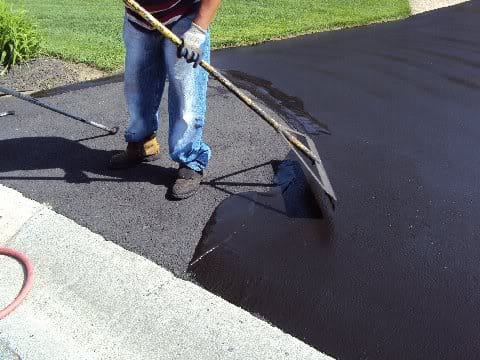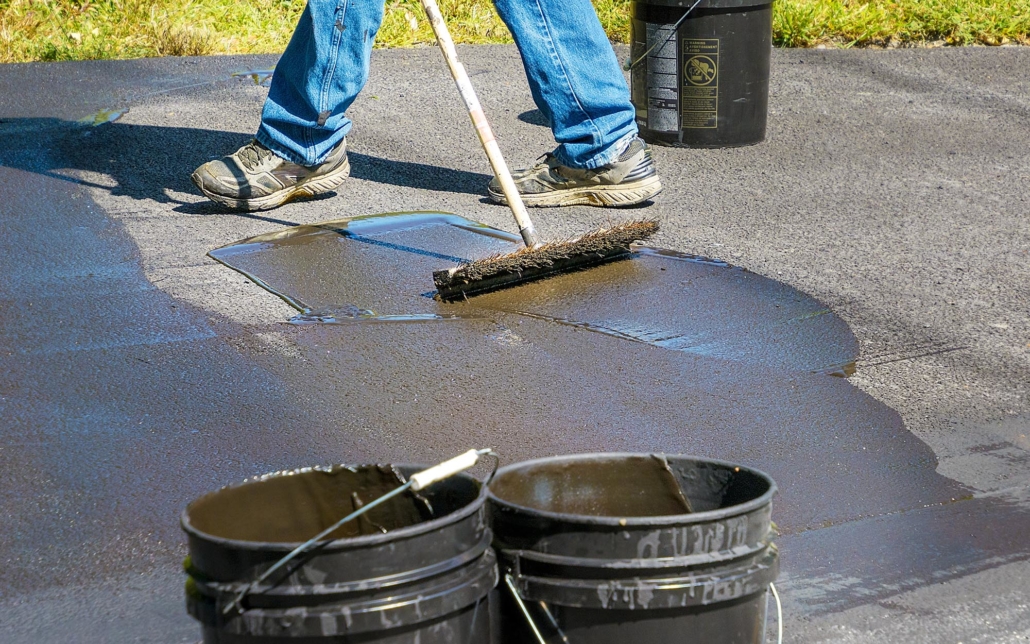Release the Potential: Regrading and Asphalt Sealing for Commercial Spaces
Release the Potential: Regrading and Asphalt Sealing for Commercial Spaces
Blog Article
Hot Mix Asphalt: A Sustainable Solution for Pavement
Warm Mix Asphalt (HMA) has arised as a leading lasting selection for pavement options, using a myriad of environmental advantages and cutting-edge innovations. As the demand for eco-friendly building and construction practices expands, exploring the subtleties of HMA's sustainability can give important understandings into the future of sidewalk solutions.
Environmental Advantages of Hot Mix Asphalt

Moreover, Hot Mix Asphalt assists to minimize urban warm island effects. Its dark color soaks up sunlight, minimizing the amount of warmth reflected back into the ambience compared to lighter-colored pavements. This can decrease ambient temperatures in metropolitan locations, decreasing the demand for a/c and inevitably decreasing power intake.
In addition, Hot Mix Asphalt adds to boosted stormwater monitoring. Its porous nature allows water to infiltrate the pavement and recharge groundwater supplies, decreasing overflow and the danger of flooding. These environmental benefits make Hot Mix Asphalt a sustainable selection for leading roadways and highways.
Energy Efficiency in HMA Production
Is energy performance an essential aspect in the production of Warm Mix Asphalt (HMA)? Energy plays a significant duty in the production of HMA, influencing both expense and environmental sustainability. One vital element of energy performance in HMA production is the usage of warm mix asphalt (WMA) technologies.
In addition, improvements in plant technologies have actually resulted in even more energy-efficient HMA production procedures. Modern plants are designed with attributes like recycled asphalt pavement (RAP) handling capabilities, effective heater systems, and enhanced insulation, all adding to energy financial savings. By optimizing power usage in HMA manufacturing, the sector can decrease its carbon impact while maintaining high-grade pavement materials. Power effectiveness is, therefore, a vital consideration in making sure the sustainability of Hot Mix Asphalt production.
Recyclability of Warm Mix Asphalt
The recyclability of Hot Mix Asphalt (HMA) is a critical element of its sustainability and lasting environmental impact. HMA is among the most recycled products in the USA, with over 100 million lots of reclaimed asphalt pavement (RAP) being reused every year in brand-new sidewalk building and construction. Reusing HMA offers a number of ecological advantages, such as decreasing the requirement for virgin materials, decreasing energy consumption throughout manufacturing, and lowering the quantity of waste sent out to land fills.
The procedure of reusing HMA entails crushing the existing sidewalk, squashing it right into smaller pieces, and mixing it with new aggregate and asphalt binder to develop a recycled mix. This recycled mix can frequently carry out as well as and even much better than traditional HMA, while calling for fewer basic materials and creating lower greenhouse gas discharges. By integrating RAP into brand-new pavement jobs, road firms can save natural sources, minimize costs, and reduce the environmental impact of roadway building and upkeep tasks. On the whole, the recyclability of HMA plays a considerable duty in promoting lasting techniques within the sidewalk industry.

Long-Term Performance of HMA
Asphalt sidewalks show durability and resilience over an extended period, showing the long-lasting performance of Hot Mix Asphalt (HMA) The longevity of HMA can be attributed to its capacity to stand up to heavy traffic lots, harsh weather, and the results of aging. Research studies have actually revealed that properly designed and effectively created HMA sidewalks can last for twenty years or more with regular upkeep. The key to taking full advantage of the long-lasting efficiency of HMA depends on making use of top quality materials, complying with ideal techniques in construction, and carrying out reliable maintenance strategies. Correct drainage, routine examinations, and timely repair services are important for maintaining the structural stability of HMA pavements over time. Additionally, innovations in HMA innovation, such as using polymer-modified binders and warm mix asphalt, have better enhanced the longevity and long life of HMA pavements. By prioritizing top quality building and upkeep techniques, HMA continues to prove itself as a lasting and affordable solution for lasting sidewalk framework.

HMA: Resilience and Sustainability
Showing both sturdiness and sustainability, Warm Mix Asphalt (HMA) has come to be a cornerstone in the building and construction of lasting sidewalk infrastructures - commercial parking lot paving. HMA's sturdiness originates from its ability to stand up to heavy lots, severe climate problems, and high web traffic volumes, making it a dependable choice for roads, highways, and airport paths. The composition of HMA, which commonly consists of aggregates, binder, and filler, plays a crucial function in enhancing its longevity and resistance to damage
Moreover, HMA's sustainability hinges on its recyclability and energy-efficient manufacturing process. The ability to reuse recovered asphalt sidewalk (RAP) in new HMA mixes minimizes the need for virgin products and decreases the ecological influence of sidewalk building and construction and upkeep. In addition, the energy efficiency of creating HMA hinges on its reduced blending temperature levels compared to other pavement materials, causing reduced energy consumption and greenhouse gas emissions.
Final Thought
In conclusion, hot mix asphalt (HMA) supplies a lasting service for pavement with its ecologically pleasant features. HMA's recyclability, power effectiveness in production, and lasting toughness make it an environment-friendly option for road building.
HMA is one of the most recycled materials in the United States, with over 100 million tons of reclaimed asphalt pavement (RAP) being reused annually in brand-new sidewalk construction.The procedure of recycling HMA includes milling the existing sidewalk, crushing it right into smaller sized pieces, and mixing it with brand-new aggregate and asphalt binder to produce a recycled mix.Asphalt sidewalks demonstrate longevity and resilience over an extensive period, reflecting the long-lasting efficiency of Warm Mix Asphalt (HMA) Furthermore, innovations in HMA modern technology, such as the use of polymer-modified binders and cozy mix asphalt, have further enhanced the resilience and long life of HMA sidewalks. The capability to reuse recovered asphalt regrading pavement (RAP) in new HMA mixes reduces the demand for virgin materials and minimizes the environmental impact of pavement building and construction and upkeep.
Report this page